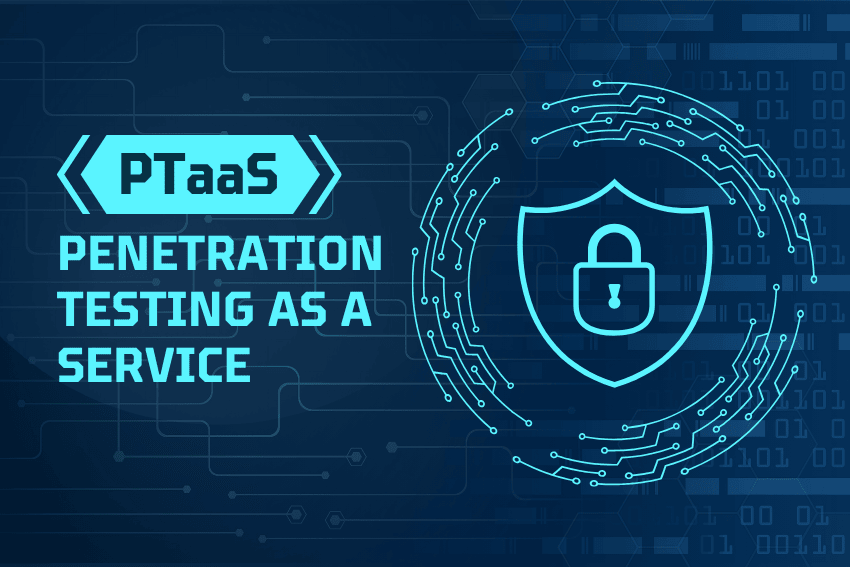Growing in complexity and scope, cyberattacks put companies in several sectors under continuous threat. Though useful, conventional penetration testing sometimes only offers a snapshot in time. Although it exposes vulnerabilities, it does not adjust well to current rapid development cycles and changing threats.

A modern technique called Penetration Testing as a Service (PTaaS) offers ongoing, cloud-based security testing. PTaaS guarantees that companies may satisfy legal obligations and create client trust while keeping pace with hackers.
What is Penetration Testing as a Service (PTaaS)?
The advancement of conventional penetration testing is Penetration Testing as a Service, or PTaaS. PTaas offers a continuous, subscription-based service rather than just once or twice annually hiring security specialists to check your systems. It uses human knowledge together with automation and cloud-based systems to continually find and fix security holes.
Access and agility define the variance. Conventional testing is frequently expensive, slow, and limited to regular check-up visits. In contrast, PTaaS provides a scalable, on-demand approach that easily suits today’s development settings. Think of it as having a dedicated security partner constantly available to help ensure the resiliency of your apps and networks.
Key Features of PTaaS
Features that set PTaaS apart include:
- Constant Testing: Unlike a one-off task, PTaaS guarantees continuous evaluation in less obscure locations.
- Real-time dashboards: These enable security teams to quickly see risks, the severity of vulnerabilities, and the status of remediation.
- DevOps Integration: Connecting with CI/CD pipelines, PTaaS enables “shift security left” by incorporating testing earlier in the software development life cycle.
- Getting Experts’ Advice: Along with automation, companies gain from ethical hackers who manually test to find sensitive flaws.
- Scalability: PTaaS grows with your infrastructure and compliance requirements, whether you are a business or a startup.
These features help you to develop a proactive security posture that changes with your company.
How Penetration Testing as a Service Works
Typically, following a rigid yet flexible approach, the PTaaS workflow:
- Set up for Engagement: Describe the testing scope, goals, and compliance criteria (such as GDPR, HIPAA, PDPA, MAS TRM, CSA).
- Automated Scanning: Initially scanning to identify typical vulnerabilities, tools act.
- Manual Testing: Skilled ethical hackers search further during manual testing, trying actual exploitation of systems to find concealed vulnerabilities.
- Reporting & dashboards: Real-time showing of results does away with the protracted delay for a final penetration testing report.
- Remediation Counseling: Exact procedures enable IT groups to address vulnerabilities quickly, aided by expert recommendations as required.
- Re-testing: Vulnerabilities are re-tested once corrections are made to verify the risk closure.
For instance, if an e-commerce site is open to SQL injection, the PTaaS provider will mark it, show programmers how to correct it, and verify that the fix works to ensure the platform is secure for transactions.
Benefits of Penetration Testing as a Service (PTaaS)
There are several strong reasons why businesses choose PTaaS:
- Faster Detection and Response: Ongoing surveillance reduces the exposure window.
- Cost-Effective: PTaaS is relatively inexpensive as it functions on a membership basis rather than on steep initial charges.
- Better Compliance: Helps in fulfilling laws, including the Cybersecurity Act (CSA), GDPR, HIPAA, Singapore’s PDPA, MAS TRM, and others.
- Developers and security teams: Cooperation among developers and security teams through shared dashboards improves communication as well.
- Scalable: Whether protecting a little app or an enterprise-level system, PTaaS fits any company.
The main advantage is that PTaaS transforms companies from a reactive to a proactive security posture.
PTaaS vs. Traditional Penetration Testing
Although both methods attempt to find vulnerabilities, there are notable differences in their approach:
- Frequency: Traditional testing is occasional; PTaaS is ongoing.
- Cost: Ordinary techniques are costly; PTaaS distributes costs with subscriptions.
- Reporting: PTaaS offers real-time dashboards; typical reports take weeks.
- Integration: PTaaS integrates with DevOps pipelines; conventional testing does not.
- Flexibility: PTaaS changes along with systems; classic testing gives a static snapshot.
In short, PTaaS matches today’s agile business strategies.
Use Cases of Penetration Testing as a Service (PTaaS)
PTaaS covers a broad spectrum of sectors:
- FinTech and Financial Services: Guaranteeing compliance with stringent regulations while protecting sensitive consumer information.
- Healthcare: Supports HIPAA and PDPA compliance as well as patient record protection.
- SaaS and E-commerce: Protects platforms from fraud, data theft, and peak-traffic downtime.
- Government & Regulated Sectors: Meets required standards such as the Cybersecurity Act (CSA) and protects critical infrastructure.
These areas handle sensitive data, so PTaaS is not only helpful but also crucial.
Challenges and Considerations
PTaaS, like all technology, has challenges:
- Dependency on Vendor Knowledge: Human testers are essential; automated scans alone won’t suffice.
- Data Privacy: These issues call for rigorous security measures for cloud-based PTaaS solutions to safeguard sensitive information.
- Selecting the Ideal Provider: Organizations should seek PTaaS providers with appropriate certifications, compliance expertise, and proven expertise.
Choosing vendors wisely guarantees the highest return on investment from PTaaS implementation.
How to Assess Penetration Testing as a Service Provider
Like any new solution in the IT market, security leaders will have to assess with great care to derive maximum value from the investment. Every dollar counts in the security budget, and emerging solutions tend to fail to deliver on their promises. Some vendors will profess to having the most current solution, such as PTaaS, to acquire or maintain customers, when the solution is actually the same offering repackaged and not equal to the actual definition established by industry analysts.
Three priorities for filtering vendors are the following characteristics:
- Full stack penetration testing capabilities.
- In-house certified penetration testers.
- Third-party security certifications.
Future of PTaaS
As cybersecurity develops, PTaaS’s future seems bright:
- AI & Machine Learning: Sophisticated analytics will enable more precise and swift identification of risks.
- Continuous Security Culture: PTaaS will ensure that it reminds everyone that security is a continuous responsibility and not a singular effort.
- Zero Trust Frameworks: PTaaS will be a key component in creating and sustaining Zero Trust architecture.
- Compliance-Based Testing: Compliance models, like PCI DSS 4.0 and repeatedly changing privacy regulations, are compelling companies to conduct more regular and documented testing.
- Hybrid Test Models: Integrating automatic scanning with expert-managed manual verification is becoming the standard for delivering depth and precision.
PTaaS will turn into a required security technique instead of just one available option as digital transformation picks up pace.
Conclusion
The following stage of proactive cybersecurity is penetration testing as a service (PTaaS). By combining automation, cloud accessibility, and human experience, it offers continuous protection, ensures conformance with global and Singapore-specific laws, and fosters collaboration between security and development teams.
For companies dealing with growing cyber risks, PTaaS helps to create resiliency and trust in an unpredictable digital environment, rather than only compliance. The time to embrace PTaaS is right now.


